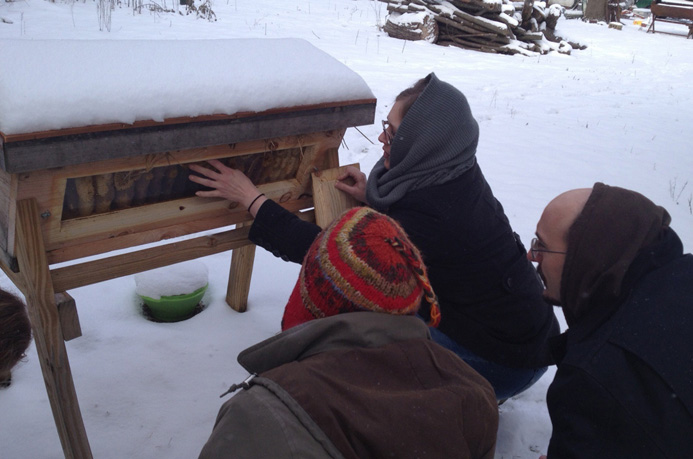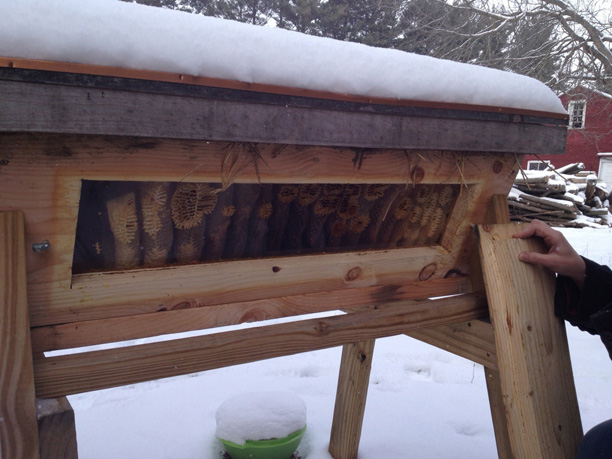As I mentioned in an earlier post, top-bar beehives seem like a great fit for backyard beekeepers. On February 3rd, my brother, dad, and I had the opportunity to learn about Kenyan top-bar beekeeping from Jessica Steller from Steller Apiaries, in Jackson, MI.
Jessica and Keith Steller have been practicing alternative beekeeping for seven years. Their focus is on sustainable beekeeping – keeping bees as pollinators in natural hives which are medication free. They specialize in removing and safely relocating “pest” colonies that have established themselves in buildings. They also produce the best honey I’ve ever tasted! It’s raw, unfiltered honey with the pollen included!
The class took place in the warm and cozy kitchen at Keith and Jessica’s house. We spent 2 1/2 hours with Jessica learning all the basics about keeping bees in Kenyan top-bar hives. The Stellers’ top-bar hives are 36″ long x 18″ wide x 9″ deep. The walls of the hives are 1 3/4″ thick, to help insulate the hives in cold Michigan winters. Jessica also took us on a short tour to see the overwintering hives.
Each of the hives has a 28″ long window that allows beekeepers to easily check on how the bees are doing, without disturbing the bees. Beekeepers that work with Langstroth hives have to open the hives up to check on the bees. This releases heat and pheromones from the hive, which makes the bees feel threatened, and they can become become aggressive in response. Langstroth hive beekeepers smoke the bees when they work with the hive, which they say calms the bees.
If smoking is done incorrectly, it can trigger an emergency “eating frenzy” response. The bees eat as much honey as possible in case they have to flee the hive because of a fire. The bees gorge on so much honey that it becomes difficult for them to bend their distended abdomens to sting. This seems far from “calming”!
Jessica said that they rarely have to smoke the bees, because they are not disturbing the hive, except when they harvest honey. They do that only once a year, in the spring. They typically only wear bee suits when they are transferring bees between hives, such as when they do a hive removal.
Because their focus is on sustainable beekeeping, the Stellers encourage hives to swarm, which is the natural way that bee colonies reproduce. When a bee colony reaches a large enough size, the workers will produce a new queen. The original queen and about half the worker bees will collect on the outside of the hive in a swarm, and then leave together. The rest of the workers remain in the original hive with the new queen, who will complete her mating flight and then start laying eggs to produce more workers.
The swarm will go to a temporary location on a tree or branch, often a short distance from the original hive. From there, scouts will check out different hive locations. The swarm will spend several hours up to several days there while the scouts collectively decide which location is best. Once a decision is made, the whole cluster of bees will fly to the new hive location.
I ordered two microhives from Jessica, which will be ready in May. These hives are 1/3 the size of the full-scale Kenyan top-bar hive with 8 top bars instead of 24. Each microhive will contain an established colony of bees made up of a queen and her workers. They will be Michigan “mutt” bees, which are feral swarms that Keith and Jessica captured last year and are overwintering now.
North America has no native honeybees. Jessica said that most of the Michigan feral bees are European dark bees. These bees were originally native to Europe from Great Britain through eastern Central Europe and were first introduced into North America in colonial times. Jessica and Keith feel that these bees are are great fit for their sustainable beekeeping practices because they are already acclimatized to Michigan. I’m excited to get my own Michigan “mutts”!


